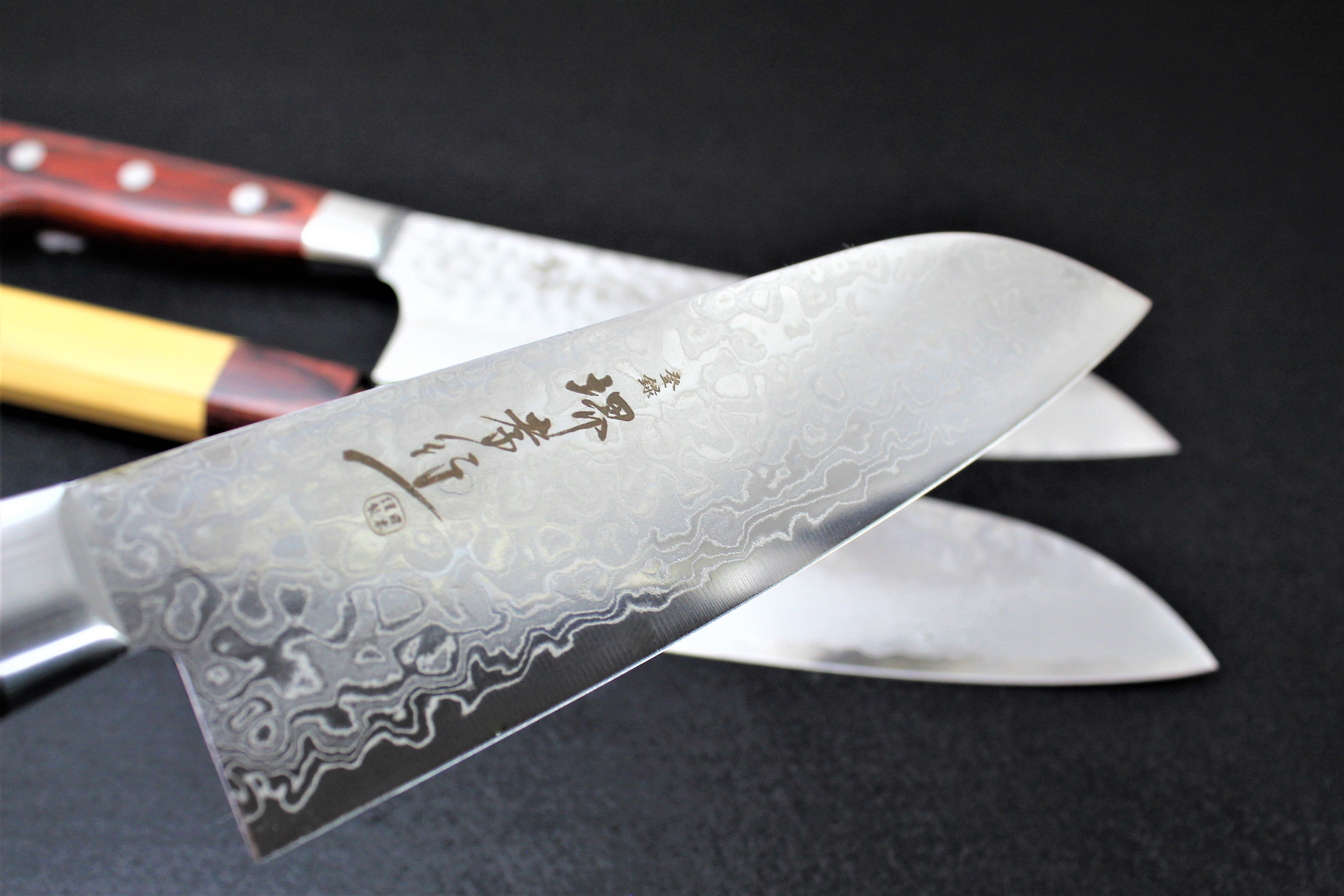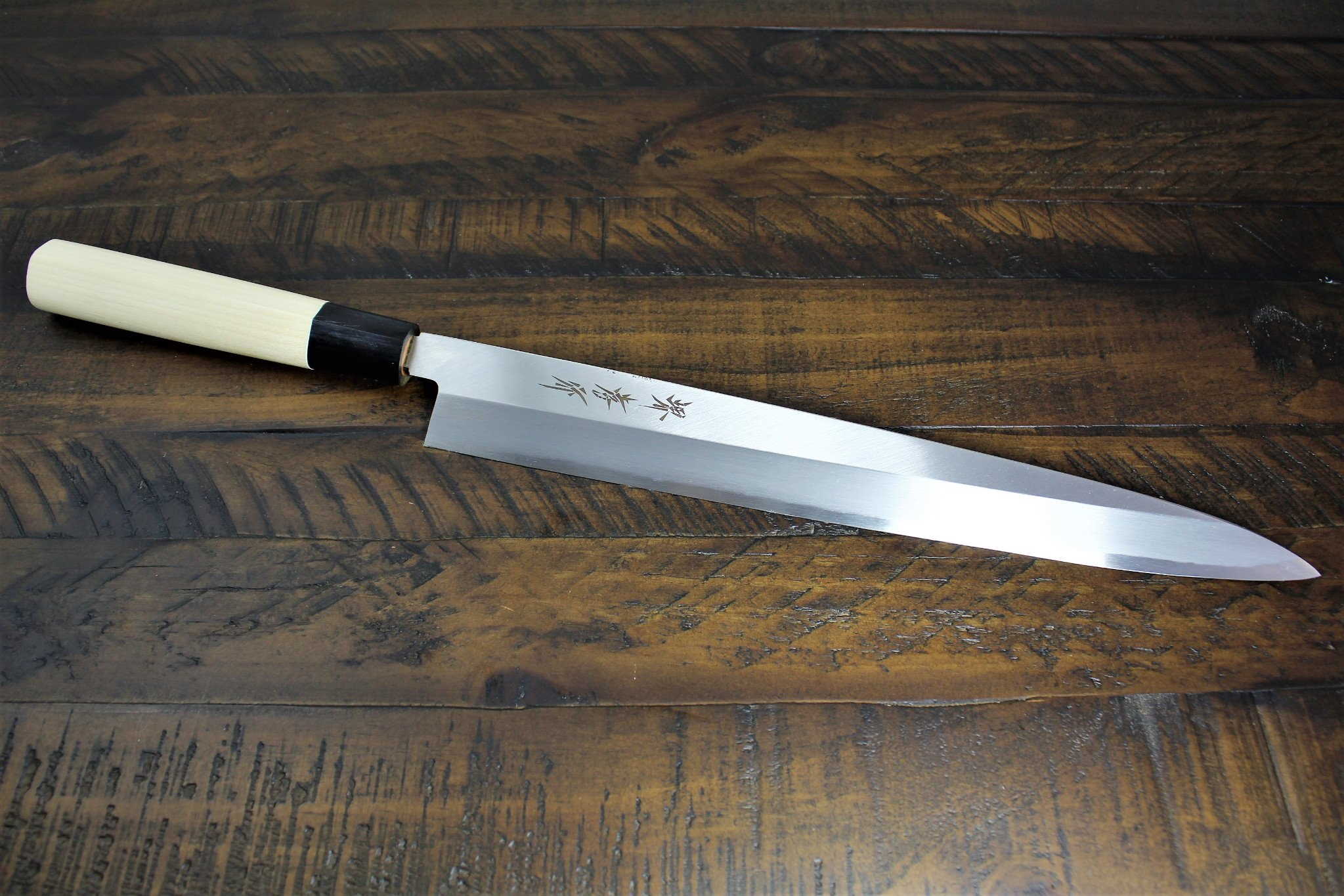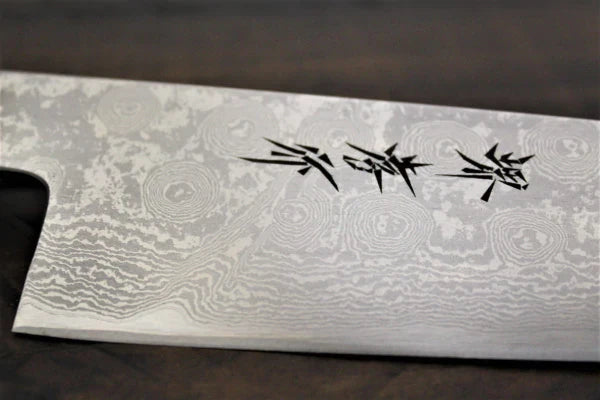
What is the best Santoku?
There’s a reason why the Santoku knife has earned a permanent place in both professional and home kitchens. With its versatility and efficient slicing power, it’s often the first Japanese blade cooks turn to when improving their knife game. If you’re trying to figure out the best Santoku knife for your needs, you’ve come to the right place.
The best choice is the Spanish Mahogany 33-layer Stainless Steel Damascus!
Just kidding, while that design is popular, it really comes down to your personal preference. At Hasu-Seizo, we want to walk you through some great options (because yes, we know there are a lot of choices).
Best Santoku Knife: What It Really Means
Finding the best Santoku knife depends on your preferences and cooking habits. Blade length, steel composition, handle style, and finish all affect how the knife feels and performs. While some may love the precision of a high-carbon steel edge, others prefer the low-maintenance durability of stainless steel.
Before selecting your next knife, consider the materials and design elements that best suit your kitchen routine and personal style.
How to choose the best Japanese Santoku knife:
- Which steel should you choose?
- Which handle style do you want?
- What size do you want?
- What about blade finish?
When you buy Santoku knives, the answers to each of these are personal. However, we can help guide you along the path and help you find the best Santoku for your style. At this point, you have probably already decided to buy a Santoku knife. However, if you are still researching, you should check out our other resources:
- What are Santoku Knives Used For?
- Should I Buy a Gyuto or Santoku Knife?
- What is the Difference Between Nakiri and Santoku Knives?
Which Steel Is Best for Your New Knife?
This is a significant question. The steel type will dramatically impact the longevity of the blade, depending on how you treat it. The two main types of steel for Japanese Santoku knives are:
- Stainless steel
- High carbon steel, typically blue steel, also known as aogami
Be honest with yourself, how do you treat your current knives in the kitchen? Do you clean them right away? Use knives for their intended purposes? Cut on a good cutting board? If so, either stainless steel or high-carbon steel may work for you. If not, you should consider the stainless steel variety .
Stainless steel kitchen knives are still excellent choices that will maintain a sharp edge, but with less maintenance required.
Don’t get me wrong, you should still treat them well, hand wash and clean them right away, but they are going to be less temperamental than their high-carbon steel cousins.
Top Stainless Steel Santoku Knife Options
- Stunning Spanish Mahogany handle
- Stainless steel VG-10 makes; one of the most trusted Japanese stainless steels available
- Hammered finish with 33-layer Damascus is aesthetically pleasing
- Heavier handle due to the type of wood and the full tang that is part of Western-style handles
- Stainless steel may need more frequent sharpening, depending on usage, than a high-carbon knife
Wa-Santoku Knife 170 mm (6.7") Damascus 33 Layer
Features:
- Striking Zelkova Japanese-style handle with a Spanish Mahogany bolster
- Stainless steel VG-10 makes; one of the most trusted Japanese stainless steels available
- Hammered finish with 33-layer Damascus is aesthetically pleasing
- Lighter handle and more forward-weighted knife due to partial tang
- Stainless steel may need more frequent sharpening, depending on usage, than a high-carbon knife
Wa-Santoku Knife 180mm (7.1") Damascus 69 Layer - Ginga
Features:
- ZA-18 Stainless steel, HRC of 61-63, makes this blade capable of a razor-sharp edge
- Wenge wood Japanese-style handle with a horn bolster
- Mirror finish 69 Layer Damascus Ginga Design (“Galaxy”)
- Lighter handle and more forward-weighted knife due to partial tang
High Carbon Steel Options
High-carbon blue steel, Aogami, is going to require more TLC. However, you can get this edge razor-sharp. If you want to buy a Santoku knife that can cut through items like butter, this is the steel for you. Its higher carbon content makes the metal harder, which also makes it more brittle and prone to chipping.
With high-carbon steels like Aogami or Shirogami (White Steel), any moisture must be removed immediately as well. Since they aren’t stainless steel, they are much more prone to rust or corrosion. When you visit a Japanese knife online store, like Hasu-Seizo, the choices can be overwhelming.
Read our article Stainless Steel Kitchen Knives vs High Carbon Steel Kitchen Knives for a more detailed analysis of the difference between steel types.
Top High-Carbon Steel Picks
170 mm (6.7") Kurouchi Aoniko / Blue Steel #2
Features:
- Striking Kurouchi rainbow finish
- Japanese-style Walnut handle with horn bolster
- High Carbon Blue Steel #2
- Razor-sharp edge
- Lighter handle and more forward-weighted knife due to partial tang
Kengata Santoku 160mm (6.3") Aogami Super Kurouchi Hammered Finish
Features:
- Kengata tip rather than a standard Santoku’s rounded tip (also known as a K-tip)
- Two-tone handle with a Zelkova Japanese wood with a Spanish Mahogany bolster
- Hammered Kurouchi finish allows easier food release
- High Carbon Super Blue Steel, Vanadium added to normal Blue Steel for durability
- Razor-sharp edge
- Lighter handle and more forward-weighted knife due to partial tang
Picking the Right Handle Style
Do you want a traditional Japanese-style handle or a Western-style handle? Traditional Japanese-style handles are typically made of wood. Some features added embellishments like a horn bolster. Meanwhile, others are crafted entirely from wood. However, the significant difference is the tang.
Tang!
No, not the tasty orange drink. We are referring to the metal from the blade that goes into the handle.
Traditional Japanese-style handles have a tang that only extends about 2/3 to 3/4 of the handle length. How does this affect you? – The balance of the blade.
Knives with traditional Japanese-style handles tend to have a more forward balance. In contrast, knives with Western-style handles and a full tang. The metal runs the full length of the handle, offering a different weight distribution.
There’s no single right answer here. If you’re comfortable with a Western-style handle and enjoy its contours and grip, stick with what works for you!
People with larger hands often grow to like Japanese-style handles once they get used to them. These handles are longer and more versatile, with no contouring to get in the way.
Three Best Santoku Knives with a Traditional Japanese-style Handle
Kengata Santoku Knife 160mm (6.3") Damascus 33 Layer
Features:
- Kengata tip rather than a standard Santoku’s rounded tip (also known as a K-tip)
- Stunning Spanish Mahogany handle
- Stainless steel VG-10 makes; one of the most trusted Japanese stainless steels available
- Hammered finish with 33-layer Damascus for a beautiful aesthetic
- Heavier handle due to wood type and full tang from the Western-style handle
- Stainless steel may need more frequent sharpening, depending on usage, than a high-carbon knife
Wa-Santoku Knife 180mm (7.1") Damascus 69 Layer - Ginga
 Features:
Features:
- ZA-18 Stainless steel, HRC of 61-63, makes this blade capable of a razor-sharp edge
- Wenge wood Japanese-style handle with a horn bolster
- Mirror finish 69 Layer Damascus Ginga Design (“Galaxy”)
- Lighter handle and more forward-weighted knife due to partial tang
Kengata Wa-Santoku 160mm (6.3") Aogami Super Kurouchi Hammered Finish
Features:
- Kengata tip rather than a standard Santoku’s rounded tip (also known as a K-tip)
- Two-tone handle with a Zelkova Japanese wood with a Spanish Mahogany bolster
- Hammered Kurouchi finish allows easier food release
- High Carbon Super Blue Steel, Vanadium added to normal Blue Steel for durability
- Razor-sharp edge
- Lighter handle and more forward-weighted knife due to partial tang
Three Best Santoku Knives with Western-style Handles
180mm (7.1") Damascus 33 Layer
Features:
- Stunning Spanish Mahogany handle
- Stainless steel VG-10 makes; one of the most trusted Japanese stainless steels available
- Hammered finish with 33-layer Damascus is aesthetically pleasing
- Heavier handle due to wood type and full tang from the Western-style handle
- Stainless steel may need more frequent sharpening, depending on usage, than a high-carbon knife
Senpuu 180 mm (7.1") Damascus Santoku
Features:
- Beautiful Damascus finish
- VG-10 Stainless Steel core
- Thin blade design for less resistance while cutting
- Contoured handle
- Stainless steel may need more frequent sharpening, depending on usage, than a high-carbon knife
INOX Pro Molybdenum Stainless Steel 180mm (7.1")
Feature
- Seamless inox molybdenum stainless steel construction
- Seamless design allows for easier cleaning
- Textured metal handle provides grip even when wet
- Stainless steel may need more frequent sharpening, depending on usage, than a high-carbon knife
Don’t Overlook the Finish for Santoku Knives
What about the finishes? While much of this is personal preference, some options make slicing easier for you.
Here are some different styles to keep an eye out for:
● Kurochi
● Kurokage
● Hammered
● Grooved
● Mirror
Have you ever noticed when you’re slicing a cucumber or tomato and the slices stick to the knife?
If so, keep this in mind when shopping at a Japanese knife shop online. Look for a hammered finish or grooves; both create air pockets that reduce suction and help release food more easily.
What about other options? There is a huge variety of other finishes out there. Many of them are stunning options that will accent your kitchen. You may see words like Kurochi or Kurokage. These are a black finish, sometimes matte, that or more in line with traditional Japanese finishing methods.
Mirror finishes are another popular technique, as these are really an eye-popping aesthetic.
What about Damascus? We can also include Damascus in the discussion about finishes, as this is primarily a technique that provides an aesthetic versus a functional feature.
Damascus is the layering of different types of steel to provide a series of waves to the cutting edge.
Many Damascus knives feature a core that forms the main cutting edge. When you sharpen the blade, this is the part you focus on. It's where the hardness and functional performance come into play.
Choosing the Best Santoku Knife
No matter which Santoku knife you buy, we are sure that you will enjoy it! Have you ever noticed that chefs carry a large knife roll with a variety of knives? That knife set is the result of years of acquiring new knives and learning how and when to use them.
No matter which one you choose, there will be the perfect time and place to use it when creating your culinary masterpieces.
You may notice we haven’t mentioned length. That’s because Santoku knives usually fall within a narrow range, typically 160–180mm, so size doesn’t vary much. On the other hand, Gyuto knives come in a wider range, and size can make a bigger difference.
If you’ve chosen your knife and are looking for a set, we bring a variety of styles, often including a Nakiri for vegetables and a petty knife for smaller tasks.
Shopping for Japanese knives online can be daunting. We hope this guide has been helpful.
Please feel free to reach out to us if you have any questions, and we can help guide you to the right knife.
Hasu-Seizo is a family-owned and operated business, proud to offer handcrafted artisan Japanese knives to clients throughout the greater Seattle region as well as the rest of the world.
Hasu-Seizo came to life out of an affinity for family history and the work performed on Sakai Takayuki brand blades in Osaka. As a family-run business based in Seattle, we deliver a wide selection of authentic Japanese kitchen knives crafted by skilled artisans.
Are you ready to upgrade your kitchen setup or start your Japanese knife journey? We invite you to explore our Santoku collection or reach out for guidance.









